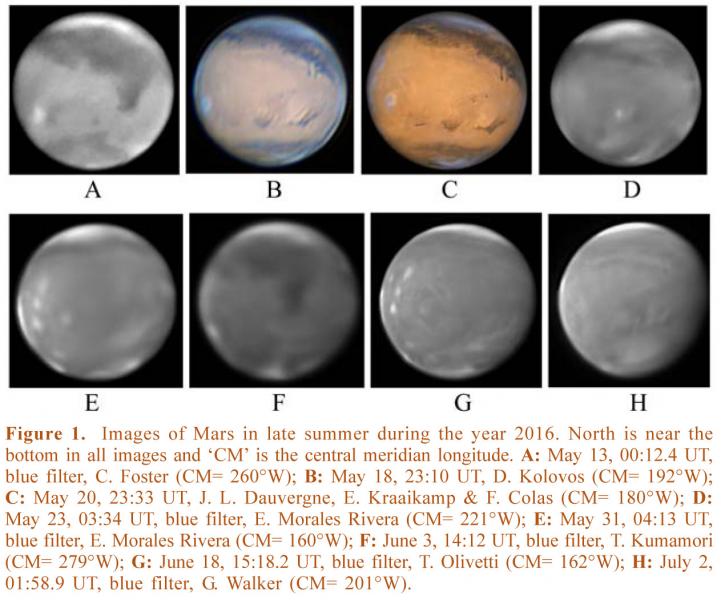The North Polar Hood of Mars
2018 November 22
Summary
The southern boundary of Mars’ North Polar Hood (NPH) was measured from 585 Earth-based images made between 2001 and 2016. This analysis covers the late summer, autumn and winter seasons for Mars’ northern hemisphere. The conclusions of this study are: 1) the NPH developed gradually during the late summer, reached its maximum extent during autumn and winter and broke up during late winter; 2) the mean latitudes, in °N, for Ls= 200°-280° (2003) and Ls= 280°-340° (2005) at local times of 8h, 9h, 10h, 11h, 12h, 13h, 14h, 15h & 16h were: 37.3, 38.0, 40.4, 42.0, 42.8, 43.7, 44.1, 44.3 & 44.0, respectively; 3) the NPH shrank, but did not disappear, during the global dust storms in 2001 and 2007; 4) the NPH boundary was about 20° farther north during the 2001 global dust storm than in 2003 at the same seasonal date near local noon; and 5) the NPH extended farther south at lower elevations in 2003 and 2005.
 Introduction
Introduction
The North Polar Hood (hereafter NPH) is a system of clouds which develops over the North Polar Region (NPR) of Mars during late summer and lasts until spring of the following year. Hereafter, the season will correspond to Mars’ northern hemisphere. A brief historical review is first presented. The goals of this study are then presented followed by a description of the method used. In the next section, the results are presented. Finally, the results are discussed.
Historical overview
J. H. Schröter undoubtedly observed the NPH in 1798. He reported that it had a ‘slightly bluish’ colour which is different from the whitish or yellowish colour he observed for the South Polar Cap.[1] C. E. Burton estimated the NPH diameter to be over 90° in late 1879.[2] G. Schiaparelli also observed parts of the NPH extending down to 50°N to 60°N during late 1879 and early 1880.[3] E.–M. Antoniadi [4] stated that white clouds are frequently observed in the NPR, and pointed out that various astronomers including F. Kaiser and himself observed them in 1864, 1896-’97, 1911 and 1926.
W. R. Dawes drew the NPH in 1864 and noticed that it covered Mare Acidalium.[5] Lowell apparently observed the development of the NPH in 1903 July at Ls= 150°.[6] Pickering presented an early photograph of ‘a temporary belt of cloud surrounding the north pole’ in his book Mars.[7] This photograph was taken in the late nineteenth century and is probably one of the first of the NPH.
De Vaucouleurs[8] reported that the North Polar Hood, which he called the ‘north polar haze cap’, is a seasonal phenomenon which develops at the same seasonal date each Mars year. In this paper he reported observing Mars between 1937 and 1969. Furthermore, he reported that this haze first develops in late summer and it thickens afterward. De Vaucouleurs also reported that its albedo is 0.3 and is less than that of the polar ice caps.[9] Slipher[10] showed several early photographs of the NPH and reported that it had moved beyond 40°N in 1960 December.
Dollfus measured a polarisation curve of the North Polar Hood in 1958.[11] This curve is similar to the polarisation curve of other white clouds on Mars. Furthermore, Martin et al.[12] reported that polarimetric measurements reported by Focus & Dollfus are consistent with the NPH being like other white clouds on Mars. Martin & McKinney[13] reported maps of the NPH during mid-1969. They also pointed out that there is no obvious or consistent relationship between surface albedo markings and the boundaries of the NPH.
Mariners 6 & 7 made several dozen images of the NPH in mid-1969 near Ls= 200°.[14] Briggs & Leovy[15] described Mariner 9 images of the NPH taken in early 1972. They pointed out that dust, condensation and lee-wave clouds developed in the NPH. Martin[16] carried out a study of the NPH during the global dust storms in 1956, 1971 and 1973 and concluded that it got smaller or disappeared during these storms.
Akabane et al.[17] used blue light photographs, made in 1969 and 1986, to measure the boundary of the NPH on the morning and afternoon sides. Their study covered Ls= 182°-199° in 1969 and L= 179°-208° in 1986. They concluded that the NPH extends to 30°N-40°N in the early morning but receded 20° farther north in the afternoon. They also concluded that the opacity of the hood is lower in the afternoon than in the morning. This was also obvious in several 2016 images of the NPH… (continued)
(Login or click above to view the full illustrated article in PDF format)
| The British Astronomical Association supports amateur astronomers around the UK and the rest of the world. Find out more about the BAA or join us. |
